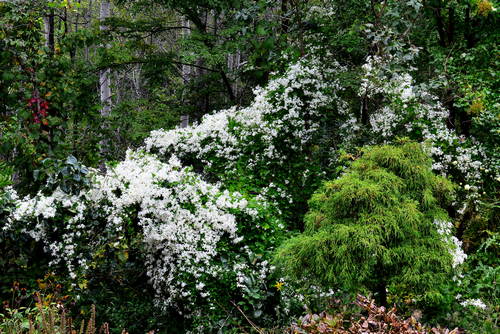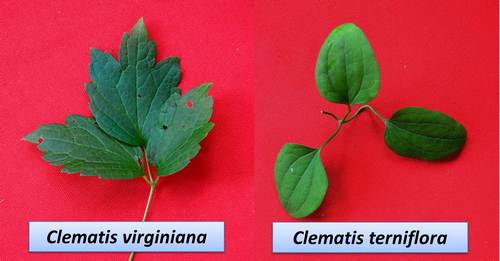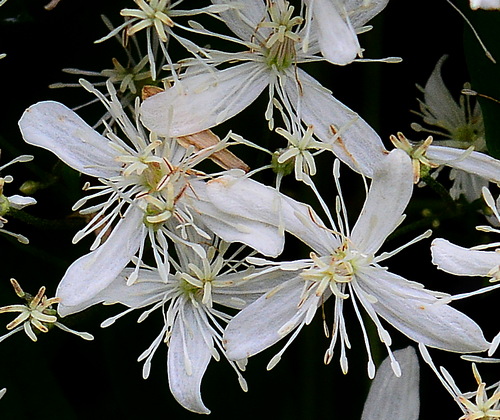Clematis terniflora, the sweet autumn clematis, is a great plant for the fall garden. It is flowering right now in a large swath that covers a mature lilac and some neighboring plants as well. It is easy to grow and flowers every year.

Clematis terniflora, by Robert Pavlis
C. terniflora also goes by the common name sweet autumn virginsbowler. Names and pictures on the internet are frequently mixed up and can be just plain wrong. This confusion is caused by three similar clematis all of which bloom in fall with white flowers.
Clematis terniflora, by Robert Pavlis
C. terniflora is an Asian species that has white flowers with four sepals. Clematis flowers don't have real petals. The stamens are quite long; almost as long as the sepals, giving it a fuzzy appearance. The edge of the leaves are mostly smooth. It is the true sweet autumn clematis and has a number of synonyms including Clematis paniculata.
Clematis paniculata is actually a completely different species from New Zealand. It also has smooth edged leaves and white flowers, but they have 6 sepals. The stamens are much shorter than the sepals. It's leaves are similar to C. terniflora. You will frequently find a plant with this name for sale, but in North America it is rarely the true plant.
Clematis virginiana, also called virgin’s bower, is native to North America, has white dioecious flowers with four sepals and look much like C. terniflora. They are hairy on the underside. The leaves on the other hand are quite different, with very definite serrations.

Comparison of Clematis virginian and Clematis terniflora, by Garden Fundamentals
All of these plants make relatively small flowers when compared to most hybridized clematis and flower in the fall. Each can be identified using the above descriptions. The small size of flowers is more than compensated for by their shear number.
The plant in the picture has been in place for about 10 years. It generally flowers quite well but not as well as this year. In spring, I dramatically reduced the size of the lilac behind it and I suspect the increase in light has given the clematis extra growing and flowering power. It has so much growth that it's bending the lilac branches over. I find this clematis grows best climbing up another shrub - the growth is too vigorous for most trellises.
The one issue with sweet autumn clematis is that it is invasive in warmer climates and has naturalized in much of the Southeastern US. In my zone 5 climate, there is not enough warm weather in fall to mature seeds and I have never found a single seedling from my two plants.
Clematis terniflora
(KLEM-uh-tiss ter-ni-FLOR-uh)
Life Cycle: woody vine
Height: 10 m (30 ft)
Bloom Time: early fall
Natural Range: northeastern Asia (China, Japan, Korea, Mongolia, Russia)
Habitat: sunny meadows, forest edges
Synonyms: Clematis maximowicziana, Clematis dioscoreifolia, Clematis paniculata
Cultivation of Clematis terniflora:
Light: full sun to slight shade
Soil: variable
Water: moist to dry
USDA Hardiness Zone: 4 - 9
Propagation: seed, softwood cuttings


